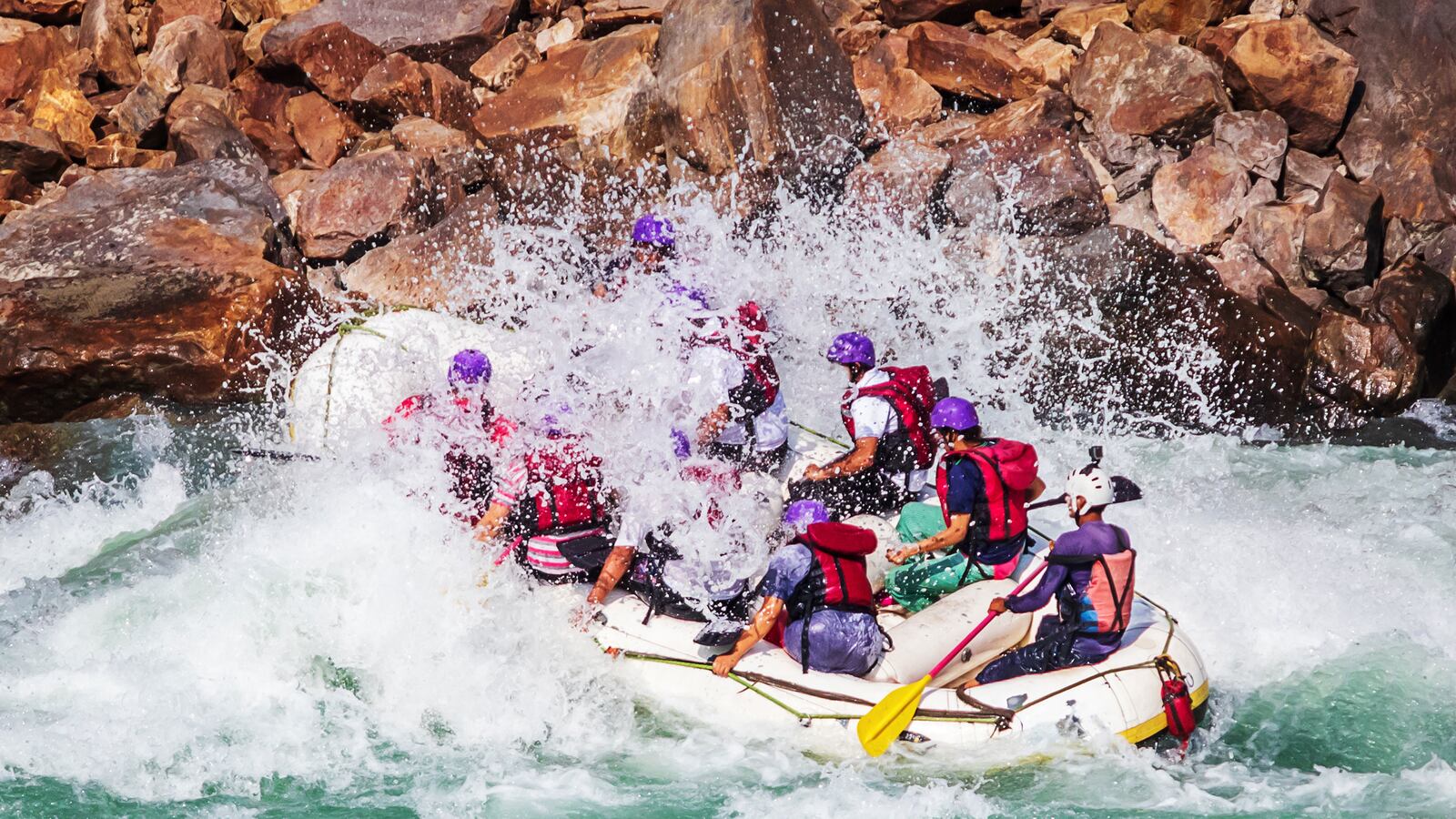We broke for a soothing masala chai straight from some stranger’s kettle and, moments thereafter, plummeted into pulverizing rapids—somehow, neither the most jarring nor disconcerting of dichotomies that day. No, merrily whitewater rafting down one of the world’s most befouled rivers takes the cake or, rather, the Indian gulab jamun.
Of course, if I’d known then what I know now, Delhi Belly wouldn’t have been the only reason I spent so much of my time in India puking buckets into battered squat toilets.
But, alas, there I was. Adrift in a raft. Surrounded by strangers. Somewhere along the gravely polluted Ganges river. In the middle of the Himalayas near Rishikesh, India. I was just a few months into my backpacking journey through South Asia—a six-month escapade when I’d promised myself I’d say “yes” to everything, if only for the story. Including this afternoon of whitewater rafting.
Hindsight is 20/20.
It took every ounce of my body—full of greasy garlic naan and spicy samosas that don’t sit so well—to grip the raft’s splintering life rope. Contrary to the captain’s order to keep pushing through the rapids together, I shamelessly tossed my paddle aside and plopped myself into the belly of the raft for a swift duck-and-cover power move. After the river swallowed the less-fortunate, tracksuit-clad man adjacent me, it was every poor soul for themselves. In my mind, anyway.
We watched his limp body bob behind ragged rocks, defenseless against the river’s wrath—a torrent perhaps teeming with innumerable lifeless bodies. The locals’ loved ones. The dead.
For him, perhaps his epic fall wasn’t unlike a holy dip.

The Ganges is deemed by Hindus the most sacred, spiritual river to pass through this planet. It rises in the western Himalayas in the northern Indian state of Uttarakhand, and it meanders some 1,569 miles southeast through the Gangetic Plain of India and Bangladesh, ultimately emptying into the Bay of Bengal.
All along the way, hundreds of millions of Hindus worship the Ganges as the goddess Gaṅgā, affectionately referred to as Maa Gaṅgā. The source provides drinking water for some 400 million people who use it to cook and believe that bathing in the river remits them of their sins and facilitates Moksha, liberation from the cycle of life and death. That’s why millions also sprinkle the ashes of their cremated deceased over the water. Those who can’t afford cremation, however, dump the bodies instead, and the banks of the Ganges are consequently infamous for those that wash ashore. After all, some 35,000 bodies are discarded in the water every year.
While the glacier-fed springs stream clearly from the icy heights of the Himalayas, pollution, untreated sewage, and burned bodies turn the river into toxic sludge by the time it reaches the sea. Read: uncollected urban trash, industrial effluents, butchers’ offal, chemical dyes from sari factories and leather tanneries, human waste, animal carcasses, partially-cremated human remains.
It takes an abiding faith to believe that the Ganges, which quickly devolves into litter-infested muck, is as pure as Hinduism trusts it to be.
But, then again, snaking through the verdant, jungled foothills of the Himalayas, I’d never have guessed the extent of the pollution problem. It’s not like I could see the decaying skeletons in the frothing rapids.
For the most part, the river lazily rolled through monkey-flecked Himalayan cedars. I floated—some might say flailed—down the river in awe of the snow-swathed mountaintops. Holy cows roamed the waterfront villages, thronged with intricately decorated shrines. A leathery old man in meditation maintained a strong scorpion pose, balancing on a bed of rocks along the shore. And the smells of food-stall spices wafted beneath my Pinocchio nose, growing because I’d sworn I’d done it all in my years of adventuring around the world.
It hadn’t yet hit me that I was so insouciantly whitewater rafting in a bath of pollution and… rotting corpses. No, I was only shocked that they’d handed me hot chai and a plated pile of rice on the raft; I’m used to canned beers and lunch-meat sandwiches, but when in India became my motto throughout my two months backpacking the kaleidoscopic country.
I’d only really grasped the magnitude of what I’d done following that evening’s riverside ceremony. Moved by the beauty of the locals’ respect for the river, I dug deep into the depths of the internet to read about its significance. (And, ultimately, its ruination.)
That ceremony was the Gaga Aarti, which I attended back in the city of Rishikesh in the Dehradun district of Uttarakhand. Every evening, as dusk descends and the sun paints the sky pinks and oranges, locals gather for a ritual of respect to the river. Barefoot, I stood there amidst hundreds of others lighting flowered diyas, or oil lamp offerings. Typically, Brahmin Pundits (Hindu priests) circle the lamps, chanting in praise of Maa Gaṅgā and singing bhajans (devotional songs), reaping the deity’s powers. Devotees cup their hands over the candles’ flames, raising the diyas for a blessing, and then floating them on the river.
Like me, visitors from all over the world come to Rishikesh to witness this ceremony, as well as to take part in a whole host of other cultural customs like Ayurveda massage, Reiki energy healing, spiritual crystallography, meditation and yoga. After all, Rishikesh is considered “the birthplace of yoga,” and it plays host to the annual, week-long International Yoga Festival.
Since ancient times, Rishikesh has been a peaceful place that lures munis, the thinkers, and rishis, those who practice a life of simplicity and renunciation, who perform penance on the riverbanks. Rishikesh is, in fact, named after the God Vishnu, who appeared to the revered Raibhya rishi in the form of Hrishikesh following a rewarding penance. Hrishikesh later became Rishikesh, which is touted today as the “Gateway to the Char Dham,” four predominantly holy temples on the hills—Kedarnath, Badrinath, Gangotri and Yamunotri.
The serene city is also full of tucked-away ashrams. Most famous, perhaps, is the Beatles Ashram. In February 1968, the Beatles traveled to Rishikesh to attend a transcendental meditation session at the ashram of Maharishi Mahesh Yogi. Their time there is largely considered their most productive, as they wrote a number of songs—reputedly as many as 48, including some for Abbey Road and The White Album. The ashram is now part of the Rajaji National Park, which represents one of India’s oldest ecosystems.
Rishikesh is growing in popularity among backpackers who come to awaken their spiritual sides. In fact, the state of Uttarakhand welcomed nearly 106,000 foreign tourists in 2015, about a 5-percent increase from the year prior. And they’re increasingly coming for Rishikesh’s adventure activities, from bungee-jumping and trekking to whitewater rafting, too.
Hotels, hostels and tour companies in the area describe Rishikesh as an adventure capital of the country, but they fail to mention that accidentally swallowing a mouthful of river water won’t only give you worms—it could also mean worms peppered in human ashes.
In retrospect, a bunch of naïve international and Indian tourists rafting down a river that so many locals revere as holy feels all sorts of disrespectful. But the industry counts on tourism. More than 300 rafting firms operate over 1,200 rafts on the 25-mile stretch from Rishikesh to Kaudiyala, employing approximately 10,000 people (guides, cooks, instructors and drivers), according to the Times of India. Adventure sports activities ring in at least about $9,745,500 USD each year. When the government temporarily banned rafting in June 2018 in an environmental effort to keep the water clean of campers’ litter and vehicles that erode the banks, thousands of locals lost business. Today, adventure activities are allowed again under stricter rules.
With the advent of India’s now-burgeoning tourist economy, blissfully unaware thrill-seekers like me can, too, find themselves whitewater rafting down one of the most contaminated and simultaneously sacred rivers in the whole world for a gripping hour or two
Maa Gaṅgā might have you dump-trucked in her rough rapids, but it’ll be a poisoning or purifying dunk, depending on how you slice the cake… or more of that gulab jamun.

